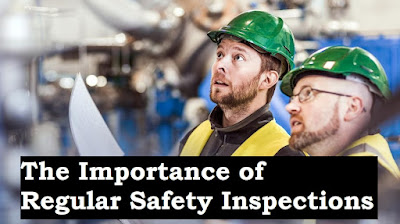The Importance of Regular
Safety Inspections
Ensuring a Safe Workplace:
The Importance of Regular Safety Inspections
As an employer, one of
your top priorities should always be the safety and well-being of your
employees. This not only includes providing a safe work environment but also
conducting regular workplace safety inspections to identify and address any
potential hazards. These inspections can help prevent accidents and injuries,
and can also protect your company from liability in the event of a workplace
injury.
What is a Workplace Safety Inspection?
A workplace safety
inspection is a comprehensive examination of a workplace to identify and assess
any potential hazards. The inspection includes a thorough examination of all
equipment, machinery, electrical systems, fire suppression systems, lighting,
ventilation, and any other factors that could potentially impact the safety of employees.
The goal of a workplace safety inspection is to identify any potential hazards
and to make recommendations for how to correct them in order to ensure a safe
work environment.
Why is it Important to Conduct Regular Workplace Safety Inspections?
Conducting regular workplace safety inspections is important for several reasons:
To Prevent Accidents
and Injuries: The main goal of workplace safety inspections is to identify and
eliminate any potential hazards that could lead to accidents and injuries. By
conducting regular inspections, you can prevent accidents and keep your
employees safe on the job.
To Comply with
Occupational Health and Safety Regulations: Most countries have occupational
health and safety regulations that require employers to provide a safe work
environment. By conducting regular workplace safety inspections, you can ensure
that your company is in compliance with these regulations and avoid fines or
other penalties.
To Protect Your Company
from Liability: In the event of a workplace injury, your company could be held
liable if it is found that there were known hazards in the workplace that were
not addressed. By conducting regular workplace safety inspections, you can
reduce the risk of liability and protect your company from potential lawsuits.
To Improve Employee
Morale: When employees feel that their safety and well-being are being taken
seriously, they are more likely to be satisfied with their job and to be more
productive. This can lead to improved employee morale and increased job
satisfaction.
What Should You Look for During a Workplace Safety Inspection?
When conducting a workplace safety inspection, it is important to look for the following:
Equipment and
Machinery: Check all equipment and machinery for proper operation, maintenance,
and safety. Ensure that all guards, shields, and warning labels are in place
and that all emergency stop buttons are easily accessible.
Electrical Systems:
Check all electrical systems for frayed wires, loose connections, and other
potential hazards. Ensure that all electrical panels and equipment are properly
grounded.
Fire Suppression
Systems: Check all fire suppression systems, including fire extinguishers,
smoke detectors, and fire alarms, to ensure that they are in proper working
order.
Lighting: Check all
lighting in the workplace to ensure that it is bright enough and free of glare,
which can cause eye strain and other hazards.
Ventilation: Check all
ventilation systems to ensure that they are providing adequate fresh air and
removing any hazardous fumes or vapors.
Electrical Work | Permit To Work (PTW)
Hazardous Materials:
Check all storage areas for hazardous materials to ensure that they are
properly labeled and stored in accordance with regulations.
Emergency Exits: Check
all emergency exits to ensure that they are easily accessible and clearly
marked.
What Should You Do After a Workplace Safety Inspection?
After a workplace
safety inspection, it is important to take action to correct any hazards that
were identified. This may involve repairing or replacing equipment,
implementing new safety procedures, or providing additional training to
employees. It is also important to document the results of the inspection and
any corrective actions that were taken. This documentation can serve as
evidence of your commitment to workplace safety and can be useful in the event
of an investigation or audit.
Free Download Excavation Entry Checklist
Additionally, it is
important to involve employees in the process of correcting any hazards.
Encourage them to report any potential hazards that they observe and involve
them in the process of identifying and correcting any issues. This not only
helps to create a safer work environment, but it also helps to foster a sense
of ownership and responsibility among employees for their own safety and the
safety of their colleagues.
Finally, it is
important to conduct regular workplace safety inspections on an ongoing basis.
This can be done on a monthly, quarterly, or annual basis, depending on the
size and complexity of your workplace. Regular inspections can help to identify
and correct any new hazards that may arise and to ensure that your workplace
remains safe for employees.
In conclusion,
conducting regular workplace safety inspections is an essential component of
providing a safe work environment for your employees. By identifying and
correcting potential hazards, you can prevent accidents and injuries, comply
with occupational health and safety regulations, protect your company from
liability, and improve employee morale. By taking workplace safety seriously,
you can create a workplace culture that values the safety and well-being of
employees and helps to ensure a safe and productive work environment for
everyone.
CONFINED SPACE SAFETY TRAINING
Concrete Pump Car Pictorial Safety Checklist
"Preventing
Workplace Accidents: The Benefits of Regular Workplace Safety Inspections"
"Ensuring a Safe
Workplace: The Importance of Regular Safety Inspections"
"Prioritizing
Employee Safety: The Benefits of Conducting Workplace Safety Checks"
"Protecting Your
Company and Your Employees: The Value of Regular Workplace Safety
Inspections"
"Preventing
Workplace Hazards: A Guide to Conducting Effective Safety Inspections"
"Building a Safe
Work Environment: The Role of Regular Workplace Safety Inspections"
"Creating a
Culture of Safety: The Benefits of Regular Workplace Safety Checks"
"The Essential
Guide to Conducting Workplace Safety Inspections for Employers".
Workplace safety, Hazard
identification, Compliance with OSHA regulations
Employee well-being, Workplace
injury prevention, Workplace safety culture
Regular safety checks, Work
environment safety.
Compressed gas cylinder safety





No comments:
Post a Comment